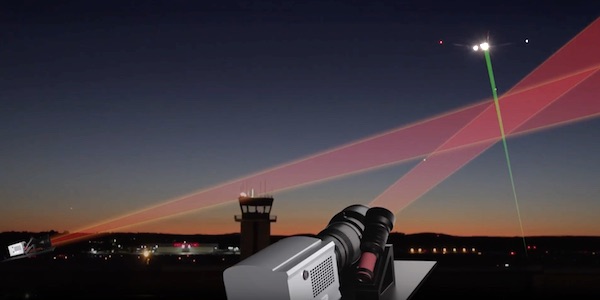Home
A comprehensive resource for safe and responsible laser use
US: MIT develops system to locate laser perpetrators using as few as two cameras, from miles away
The Laser Aircraft Strike Suppression Optical System (LASSOS) uses two or more low-light CCD sensor cameras that observe the night sky, each with a star tracker that determines the attitude of the sensor. The cameras observe a volume of airspace such as around an airport. Beam locations are identified by analyzing the two (or more) different views to find the endpoint of the laser beam.

In one test, LASSOS identified the ground location of a laser beam aimed into the sky, using two cameras located nine nautical miles away. The locations was determined within 30 seconds. The system was so accurate that it could differentiate between locations separated by only 5 meters.
A key attribute of LASSOS is that the final output is a Google Earth map with the beam and perpetrator location overlaid. This makes it easy for law enforcement to know the area they will be searching for the perpetrator.
An MIT press release gave no indication of potential installation and operational costs, and did not indicate any further plans for testing or implementation.
LASSOS was developed under Air Force Contract No. FA8721-05-C-0002 and/or FA8702-15-D-0001.
From a September 2017 MIT Lincoln Laboratory press release, reprinted below (click the “read more” link.) MIT also has a YouTube video of the system; the LASSOS description begins about 56 seconds into the video. Thanks to Greg Makhov, who brought this to our attention via a Tech Briefs article printed in January 2018.
US: FBI uses sophisticated surveillance to catch Portland man who lased ~25 aircraft
The operation was initiated in August 2013, after multiple incidents of lasers being aimed at aircraft around Portland International Airport. Four law enforcement aircraft were equipped with video surveillance cameras.
On August 10, five aircraft were targeted by a ground-based green laser. One was an Alaska Airlines flight; two were from the FBI and two were from the Portland Police Bureau. At the same time, a surveillance team was on the ground. Using information from the FBI/PBB aircraft sightings, the ground officers observed suspicious behavior from a male in the back yard of a duplex apartment. He was looking up at the sky. He removed something mounted from a stand or pole, and went inside. The laser strikes ceased afterwards.
Six days later, after reviewing the video, consulting Google Earth and Google Maps, and visiting the apartment complex, an FBI Special Agent determined that Apartment 35 -- the one previously surveilled -- was the most likely source of the laser. The apartment was occupied by 39-year-old Stephen Francis Bukucs.
Surveillance cameras were then secretly installed, watching Apartment 35. They could see in daylight, low light and nighttime (using infrared).
Click to read more...